Effective Strategies for Removing Red Wine Stains
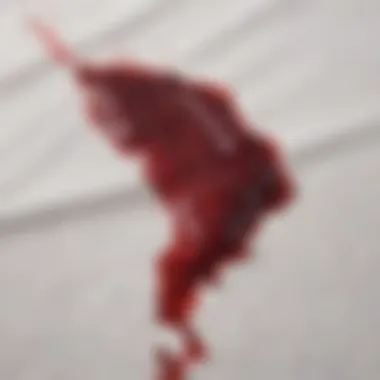
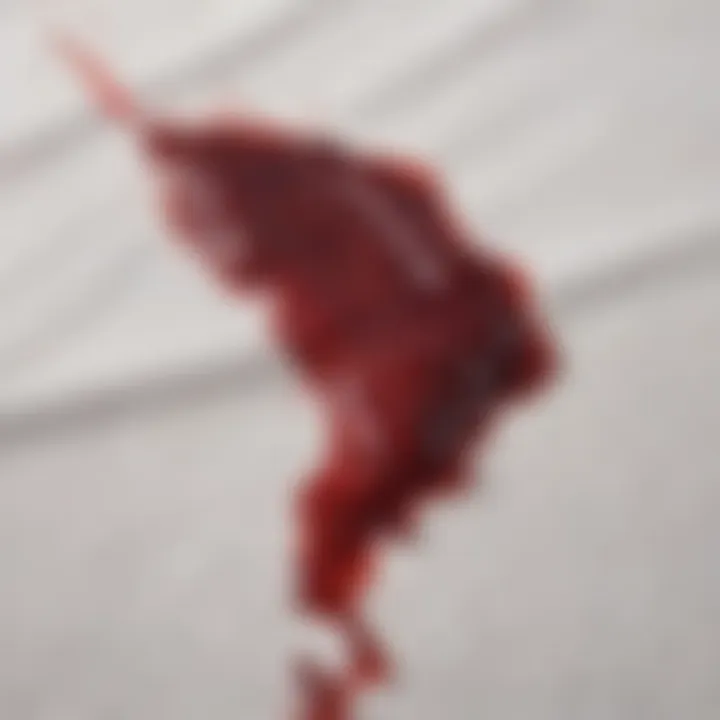
Intro
Red wine stains on white shirts can feel like a fashion nightmare, often leading to despair at dinner parties or elegant gatherings. The bright hue of red can seep into fibers, leaving a mark that seems nearly impossible to remove. However, fret not; with the right approach and tools at your disposal, there are effective strategies to tackle this common mishap.
Understanding the nature of red wine stains is crucial. These stains are primarily caused by pigments called anthocyanins, which are known for their vibrant colors. When they come into contact with fabric, they can bond in a way that makes removal tricky, especially on delicate materials like cotton or linen.
Despite that, responding promptly and using the correct techniques can work wonders. The upcoming sections will equip you with a range of methods to mitigate these unsightly marks, from immediate actions one can take in the heat of the moment to laundry and cleaning solutions that can be employed at home. This guidance isn’t just for the "oops" moments; it’s about maintaining the integrity of your favorite garments while still enjoying that glass of Merlot.
Understanding Red Wine Stains
Red wine stains are often considered the nemesis of white shirts, causing distress in social settings and at family gatherings. Knowing how these stains occur, as well as understanding their makeup, can significantly alter your approach to cleaning and preserving your garments. Whether you’re relishing a glass during a dinner party or just enjoying a casual night in, spills can happen.
Understanding red wine stains goes beyond merely combating a mishap; it's about acknowledging the chemistry that makes these stains such a nuisance in the first place.
The Chemistry of Red Wine
Red wine, while delightful to sip, possesses unique properties that contribute to its staining power. It’s packed with pigments, known as anthocyanins, which are responsible for the deep red color that pleases many palates. Alongside these pigments, other compounds, like tannins, are present. Tannins are a type of polyphenol that can latch onto fabric fibers, making the stain more stubborn. This dual-pronged approach of color and adhesion is what elevates the red wine stain from a mere inconvenience to a formidable challenge.
- Anthocyanins: These are the pigments that give red wine its vibrant hue. They're known for being water-soluble, which means they easily diffuse into the fibers of your shirt.
- Tannins: As mentioned, these compounds find a cozy home among fabric threads, making it hard for your efforts at cleaning to bear fruit.
Each sip you take comes with a potential risk to your cherished attire; thus, awareness of these elements can help in devising effective removal strategies.
Why Stains are Difficult to Remove
The reasons red wine stains thwart easy removal are tied directly back to the chemistry discussed above. The very mechanisms that make red wine delicious also contribute to its stain-making prowess. As the wine seeps into the fabric, the combination of tannins and pigments forms bonds deeper than just surface level. A few factors add to the complexity of this issue:
- Time: The longer a stain sits, the more it sets. As the moisture evaporates, the compounds bond exceptionally well with the fibers.
- Fabric type: Natural fibers like cotton absorb liquid more than synthetic fibers, making removal tougher on certain fabrics. An expensive cotton shirt may be more vulnerable than a polyester blend in terms of staining.
- Temperature: Heat can actually lock the stain in, rather than help in its removal, leading to more diligent strategies needed to tackle any remaining marks.
In summary, understanding red wine stains is an essential first step in your journey toward conquering them. Acknowledging the chemistry and challenges involved equips you to act swiftly and effectively, ensuring your white shirts retain their charm with each wear.
Immediate Actions to Take
Taking swift action is crucial when it comes to tackling red wine stains on white shirts. The longer a stain sits, the more entrenched it becomes, making it tougher to erase. In the world of stain removal, time is of the essence. The faster you respond to the spill, the greater your chances of saving the garment.
When red wine ends up in an unintended spot, it can be a real heart sinker, but don’t let panic set in just yet. Immediate actions can dramatically influence the outcome. Here are some immediate strategies to consider:
- Stay Calm: It's easy to feel frustrated or helpless, but remember that an effective response often starts with a clear mind.
- Avoid Rubbing: Rubbing the fabric can spread the stain even further. It’s like trying to push a poppy seed into dough – you’ll only make it worse.
- Assess Your Environment: Check what tools and resources you have on hand. Sometimes, the most effective solutions come from unexpected sources in your kitchen or wherever you may be.
Blotting the Stain
Blotting is arguably the most important immediate action you can take when faced with a red wine mishap. This technique is less about scrubbing and more about carefully lifting the liquid away from the fiber before it can set into the material. Here’s a step-by-step guide:
- Grab a Clean Cloth: Ideally, find a white cloth or paper towel to avoid transferring color.
- Dab Gently: Use a dab-and-lift motion; simply press against the stain, allowing the cloth to absorb the wine. Don’t rub or wipe, as this will force the wine deeper into the fabric.
- Rotate the Cloth: Every few dabs, turn the cloth to a clean area. That way, you’re not reapplying the absorbed wine back onto the shirt.
- Keep Blotting: Continue the process until no more wine lifts off onto the cloth. It might take some time, and patience here pays off.
"When dealing with stains, remember: Blotting is key. Don’t rub your troubles deeper!"
Blotting effectively minimizes the spread of the stain, and it prepares the fabric for further treatment. Once you’ve soaked up as much of the wine as possible, you can proceed with home remedies or stain removal products. Doing this can ultimately save your prized white shirt from becoming a casualty of a dinner mishap.
Household Remedies for Stain Removal
Household remedies for stain removal hold significant importance in the battle against red wine stains on white shirts. Not only are these methods cost-effective, but they also utilize common items found in many kitchens, making them accessible to anyone facing a wine spill disaster. The big advantage of going the homemade route is that you can act swiftly without needing to run out and purchase specialized products. Furthermore, these solutions often target the stain's composition directly, helping to break down the pigments responsible for the unsightly marks.
What’s more, many of these remedies are gentle on fabrics, reducing the risk of damaging your favorite shirt while still being effective. They can be particularly beneficial for those who prefer natural cleaning alternatives, steering clear of harsh chemicals. So, let’s dive into a few popular household techniques, carefully exploring how each can help in those sticky situations.
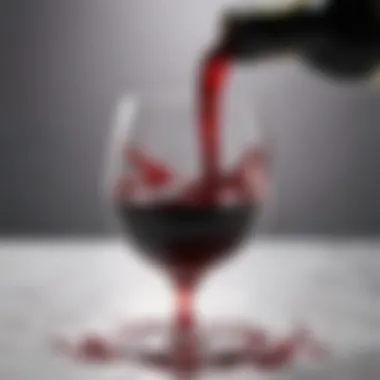
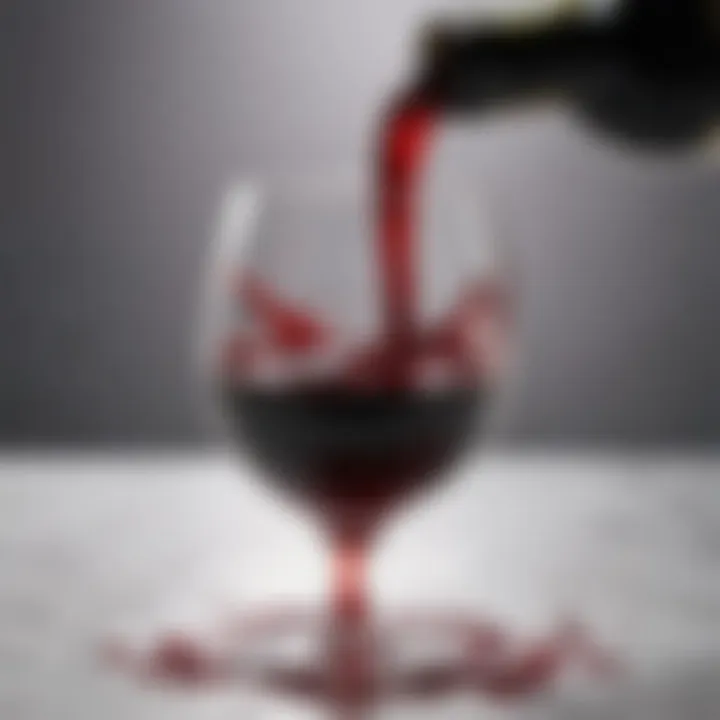
Salt and Water Technique
The salt and water technique is a classic method that's as easy as pie. This approach hinges on salt's natural abosorbent properties, which can help pull the wine out of the fabric.
To apply this method, you’ll want to take a generous sprinkle of salt immediately after the stain occurs. The idea is to cover the stained area, allowing the salt to absorb as much of the wine as possible. After sprinkling, let it sit for about five to ten minutes. As you wait, it's a good time to ponder over more serious matters rather than the imminent laundry you face.
Once the time is up, you can gently blot the stain with a clean cloth, making sure not to rub it in further. Rinsing the shirt under cold water afterward is a crucial step to wash away the salt and any remaining wine residue.
Baking Soda Paste Method
Shifting gears, we arrive at the baking soda paste method. This approach is particularly helpful when you're dealing with older stains that have settled in. Baking soda, a kitchen staple, is full of cleaning potential. To create the paste, simply mix two parts baking soda with one part water until you achieve a spreadable consistency.
Apply the paste directly to the stained area, gently working it in to ensure that it seeps into the fabric. After letting it sit for about 30 minutes, simply rinse it off with cold water. Not only does this method work wonders, it may also leave your shirt smelling a bit fresher.
Vinegar and Dish Soap Solution
The vinegar and dish soap solution is another heavy hitter in the realm of home remedies. Vinegar, with its acetic acid, is effective in breaking down stains while dish soap cuts through the grease. A simple concoction of one cup of white vinegar, two cups of water, and a tablespoon of dish soap works quite spectacularly.
You can apply this mixture using a clean cloth or sponge, gently dabbing the affected area. Let it sit for about ten minutes. This step allows the vinegar to do its magic, breaking down the red wine's pigments. Afterward, wipe away with a clean damp cloth to rinse off the vinegary solution. The result? A cleaner, stain-free shirt without having to break the bank.
"Home remedies can be effective allies in the ongoing war against stubborn stains. With common household items, you can often save the day, and your favorite shirt."
Incorporating these household remedies into your stain-fighting arsenal not only prepares you for the unpredictable nature of dining experiences but also encourages quick responses that can preserve your garments. Using these practical, everyday solutions can provide a sustainable approach to home cleaning.
Commercial Stain Removal Products
Commercial stain removal products are a crucial element in the fight against red wine stains on white shirts. While household remedies can be effective, sometimes the potency of specialized products is needed to reclaim your fabric from the grip of stubborn stains. When you've tried the simpler methods without success, knowing the options available in the market can be a lifesaver.
These products come equipped with enzymes and surfactants specifically designed to target and break down the chemical compounds in red wine. Each product can boast unique combinations of ingredients, tailored to tackle different types of stains. These specialized formulas aren’t just hit-or-miss; they often come with instructions optimized for various fabrics. Having them on hand means you can act quickly when an unfortunate spill occurs, giving you the best chance of restoring the appearance of your favorite shirts.
Types of Stain Removers Available
When it comes to commercial stain removal products, there’s a wide range available. Each type serves its own specific needs:
- Spray Stain Removers: Often in convenient pump or aerosol bottles, these can provide targeted application, making them ideal for spot treatments on the go.
- Liquid Laundry Detergents: Many brands offer formulations specifically designed to tackle tough stains. Their liquid nature allows for deeper penetration into the fabric fibers.
- Stain Removal Wipes: Handy wipes that can be tossed in your bag. They’re perfect for on-the-spot cleanup when you’re at a gathering.
- Powder Stain Removers: These come in a powdered form and can be mixed with water to create a paste for rigorous treatments.
- Stain Removal Gel: The gel forms can cling to the fabric longer, allowing for deeper treatment before washing.
Understanding these types helps in selecting the right product based on your immediate needs and fabric type.
How to Choose the Right Product
Choosing the right stain removal product can feel overwhelming given the myriad of options available. Here are some guiding factors:
- Fabric Type: Always check if the product is compatible with the fabric of your shirt. Delicate materials may require gentler products.
- Stain Severity: Consider how long the stain has been set in. Heavily soiled items often need stronger formulations.
- Ingredients: Opt for products with enzyme-based formulations, as they are particularly effective against organic stains like red wine. Check for non-toxic ingredients if you’re looking for something safe for family use.
- Usage Instructions: Check the label for specific application tips and whether it requires pre-soaking or is effective in a cold wash.
- Reviews and Recommendations: Reading reviews or checking recommendations helps in narrowing down products that others have found effective.
"It's not about having the best product, but having the right product for the job."
In sum, commercial stain removal products serve as a vital component in managing red wine accidents on white shirts. Understanding the different types and knowing how to select the right product enhances your chances of maintaining the integrity of your wardrobe.
Pre-Treatment Techniques
When it comes to tackling red wine stains on white shirts, pre-treatment techniques play an essential role. These techniques not only mitigate the immediate appearance of the stain but also set the stage for successful removal during the washing process. One of the most significant benefits of pre-treatment is that it reduces the potential for the stain to become set, which often happens when the fabric is washed without proper intervention. By applying the appropriate pre-treatment methods, one can significantly increase the chance of restoring the garment to its original state.
Evaluating the fabric type is also vital; different materials respond uniquely to various treatments. Knowing the right approach is critical to preserving fabric integrity. A rushed or improper technique may lead to further damage, which is the last thing anyone wants when dealing with an unexpected spill. Thus, considering factors like the fabric's composition, the size of the stain, and how long the wine has been on the shirt can impact your course of action.
Soaking the Garment
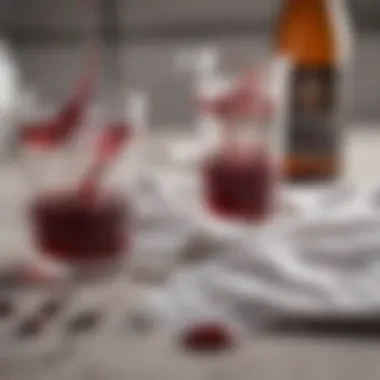
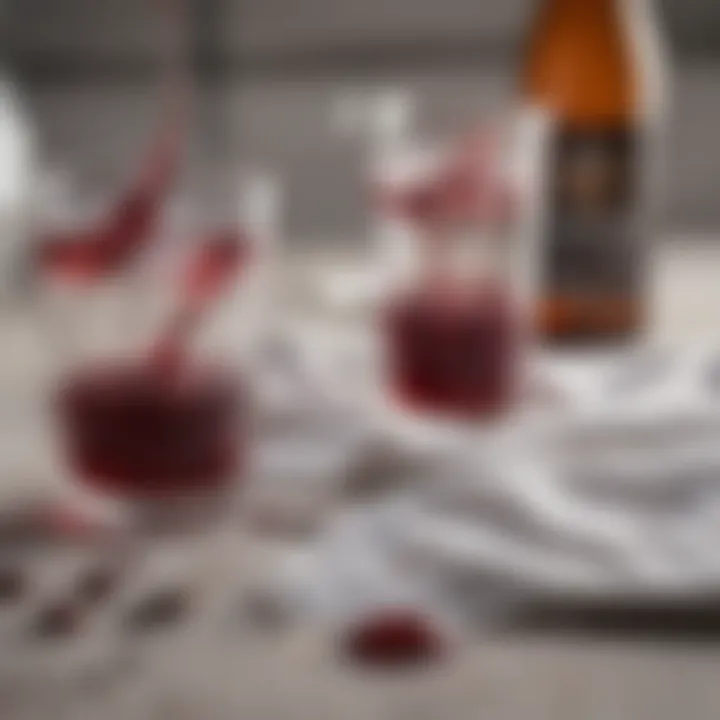
Soaking the stained garment can be an effective initial response to a red wine mishap. By submerging the affected area in cold water, you bring down the concentration of the stain and slow down the absorption of the wine into the fabric fibers. This method works particularly well if you catch the stain early.
- Use cold water: Hot water might further set the stain, making it more difficult to remove.
- Soak duration: Allow the garment to soak for about 30 minutes to one hour. This gives time for the water to loosen the stain’s grip on the fabric.
- Spot testing: If you’re unsure how the material will react to soaking, it’s prudent to do a spot test on an inconspicuous area first.
After soaking, gently blot the area with a clean cloth to remove as much of the residue as possible. Avoid rubbing, as this can push the stain deeper. If the stain persists, moving on to further treatment options can be a good idea.
Spot Treatment Considerations
Spot treatment is about analyzing the stain and deciding on the best method to tackle it. This tailored approach allows for a more focused attack and often yields a better outcome than general cleaning strategies.
- Identify the stain age: Older stains are more stubborn, requiring more aggressive treatment methods, while fresh stains often respond better to gentler options.
- Select the right agent: Depending on what you have on hand, you might choose dish soap, vinegar, or specialized stain removers for spot treatment. Which route you take can depend on the fabric type and the stain's severity.
- Application method: Apply your chosen treatment directly to the stain with a soft cloth or your fingers, working from the outside toward the center to avoid spreading the stain. Let it sit for several minutes before rinsing with cold water.
- Avoid heat until removal: Do not put the garment in the dryer or use heat on the stained area until the stain is fully removed. Heat can make it virtually impossible to get the stain out.
"The earlier you act, the better your chances of success. Stains are like uninvited guests; the quicker you address them, the less they linger."
Washing the Stained Item
When it comes to dealing with red wine stains on white shirts, washing the stained item becomes a pivotal step in restoring the garment to its former glory. Many folks often underestimate the power of a good wash, thinking that blotting or using a quick remedy is enough. But, washing effectively is where you can save your garment from becoming a story of regret. The washing process not only helps to lift the wine residue from the fibers but also prepares the shirt for a potential future life of service.
The washing stage serves different purposes: it not only cleans what’s left of the stain but also helps in removing any cleaning agents you may have applied earlier. Moreover, it's during the wash cycle that you can introduce an extra punch to your stain-fighting efforts. As we dive into the specifics of this washing process, it’s clear that implementing the right techniques can significantly enhance your outcomes and keep your shirt looking crisp.
Optimal Washing Machine Settings
Getting the washing machine settings right is crucial. When faced with red wine stains, the general temptation is usually to crank up the heat and go for a heavy-duty wash. However, this approach can sometimes backfire, especially if the garment's fabric is delicate or if the stain hasn't been adequately treated. Consider these insights when setting your washing machine:
- Water Temperature: Cold water is often the best bet when washing wine-stained fabric. Heat can set the stain deep into the fibers, making it almost impossible to remove. Cold water helps to gently lift stains without damaging the fabric.
- Cycle Type: Opt for a gentle cycle, particularly if the fabric is soft or has embellishments. A harsh cycle can do more harm than good, sometimes causing irreparable damage.
- Load Size: Avoid overloading the machine. Less laundry in the drum allows for better agitation and ensures that each garment gets adequate contact with water and detergent. Think of it like cooking in a cramped kitchen—everything just turns into a messy situation.
Choosing the Right Detergent
Choosing the right detergent can be the ace up your sleeve in the battle against red wine stains. With countless options on the market, this decision becomes crucial for successful stain removal. Keep in mind these vital factors while selecting your detergent:
- Enzyme-Based Detergents: Look for those that contain enzymes specifically formulated to break down organic stains. An enzyme-rich detergent can work wonders on red wine. They act almost like microscopic soldiers, targeting the stain at its core.
- Avoid Fabric Softeners: While they might make your clothes smell delightful, fabric softeners can leave a residue that traps stains instead of lifting them. Stick to a straightforward detergent without extra additives.
- Pre-Stain Formula: Some detergents come specifically designed for pre-treating stains. Using such formulas can provide that extra layer of cleaning prowess.
Getting the wash just right, from settings to detergent, can significantly increase the likelihood of vanquishing that stubborn red wine stain. With the right actions, your beloved white shirt may just avoid the fate of being relegated to the back of your closet.
Drying and Ironing Techniques
When it comes to preserving the appearance of your white shirt after an unfortunate red wine spill, drying and ironing properly are just as crucial as the stain removal process itself. These steps could make the difference between a well-preserved garment and one that succumbs to discoloration or damage. Understanding the nuances of drying and ironing can significantly prolong the life of your fabric and restore its elegance.
Air Drying vs. Machine Drying
Air drying and machine drying each have their merits and drawbacks.
Air Drying is often the gentler option. It allows the fabric to dry naturally, which can minimize any potential heat damage that might occur in a dryer. Here are some things to keep in mind about air drying:
- Gentle on Fabrics: Reduces risk of shrinking or distorting the shirt's shape.
- Sunlight Considerations: Direct sunlight can help lift remaining stains but be careful, as it may also lead to fading over time.
- Space requirement: Air drying typically takes longer and requires space, so plan accordingly.
On the flip side, Machine Drying offers speed and convenience, but it can come with a caveat. High heat is often a foe to delicate materials. Here are key points about machine drying:
- Check Settings: Use a low heat cycle to avoid scorching the fabric.
- Avoid Overdrying: Pull the shirt from the dryer while it’s still slightly damp to prevent excessive wrinkling.
- Immediate Action: Once dried, promptly remove the shirt from the dryer to minimize creases.
Both methods aim to remove moisture from your white shirt, yet which one you choose can hinge on the fabric type and the urgency of the situation.
Ironing Recommendations for Stained Fabrics


Ironing can feel like the final hurdle in restoring your white shirt to its former glory. However, tackling stained fabrics calls for special caution. Always remember:
- Cool Off: Let the garment cool down after drying. Ironing while the shirt is still warm can set in any remaining stain.
- Right Temperature: Set the iron to the appropriate temperature based on fabric type—usually, a lower setting for synthetics and a higher one for cotton.
- Test First: It's often wise to test the iron on a hidden seam or corner to ensure it won’t burn or discolor the fabric.
- Use a Cloth: Consider placing a thin cotton cloth over the stained area before ironing. This can provide an extra layer of protection, reducing the risk of scorching.
- Steaming: If possible, steam the shirt; this can ease out wrinkles without direct contact from the iron, which is safer for still-stained areas.
Remember, patience is key in both drying and ironing. The more effort you put in here, the better your shirt will look afterward.
In summary, drying and ironing techniques are critical for maintaining the beauty and integrity of your white shirt post-wine incident. By opting for the right drying method and handling the iron with care, you're likely to walk away with a garment that looks nearly as good as new.
Preventive Measures
When it comes to avoiding the headache of red wine stains, the old adage "an ounce of prevention is worth a pound of cure" rings especially true. Preventive measures are key not just for maintaining the appearance of white shirts but also for easing the laundry process. Making wise choices can save both time and resources in the long run.
Choosing Stain-Resistant Fabrics
Selecting the right fabric when purchasing shirts is a game-changer. Not all materials are created equal under the scrutiny of a red wine spill. Fabrics such as polyester or treated cotton have a natural resistance that can help ward off stains. For example, a shirt made of a tightly woven fabric will often resist absorption better than those with a looser weave, creating a barrier that prevents wine from penetrating deeply into the fibers.
Here are some key points to consider when choosing stain-resistant fabrics:
- Look for Labels: Fabrics labeled as stain-resistant often undergo treatments that significantly repel liquids.
- Material Matters: Synthetic fabrics generally resist staining better than natural ones. For high-stakes situations, consider blends that include stain-resistant treatments.
- Beware of Light Colors: While white looks pristine, some lighter hues, like pale pastels, may not offer the same defensive properties. Aim for fabrics that remain vibrant against potential stains.
By making informed choices about fabric, you can safeguard your wardrobe against that dreaded red wine mishap.
Practical Tips to Avoid Stains
Even with the best fabrics, the occasional spill can happen. However, there are practical strategies you can apply to minimize your risks. Adopt these tips in various settings—be it at home, at a restaurant, or during a gathering with friends.
- Sit Smart: When dining, choose a seat away from clumsy servers or fellow diners who may not be as vigilant with their red wine glasses.
- Hold Your Glass Right: Grasp wine glasses by the stem rather than the bowl. Not only does this reduce the risk of a slips, but it also keeps the bowl clean—no fingerprints or accidental spills.
- Use Tablecloths: When hosting events, consider using a tablecloth. It’s easier to wash a fabric surface than to tackle stains on every shirt that comes in contact with the table.
- Act Quickly: Always have napkins or cloths nearby. If a spill happens, using these items as soon as possible can absorb excess liquid before it sets.
By integrating these simple habits into your daily life, you can greatly reduce the odds of getting caught in a wine stain dilemma. Every small effort contributes to the greater goal of maintaining the fresh look of your favorite shirts.
Remember, being proactive now will save you from regretting later.
In summary, whether through careful fabric selection or practical day-to-day choices, incorporating these preventive measures will go a long way. They not only protect your clothing but also provide peace of mind so you can enjoy those social occasions without worry.
When to Seek Professional Help
At some point, despite our best efforts with household remedies or even commercial products, a stubborn red wine stain can just refuse to budge. It's in these moments that knowing when to call in the pros becomes crucial. Seeking professional help is not about throwing in the towel; rather, it’s about making a savvy decision that can save your beloved garment from further damage.
Signs You Can't Remove the Stain
Sometimes, the evidence is clear that attempts to scrub out a red wine stain are going down the wrong path. Here are several indicators that might suggest it’s time to consult a cleaner:
- Persistent Color: If the stain remains vivid even after multiple treatments, this could be a sign that it has already set deep into the fabric fibers.
- Faded Fabric: Excessive scrubbing or harsh chemicals can lead to fading. If the fabric shows signs of wear and tear from your attempts, putting it in the hands of a professional may prevent further deterioration.
- Fabric Sensitivity: Delicate materials, like silk or fine linen, require specialized care. If your garment is made from one of these fabrics, it’s best left to a professional who understands the nuances.
- Stain Size and Location: Larger stains or those in visible areas are especially problematic. If you have a sizable blotch in the front of a white shirt, it might be worth a professional assessment.
- No Results: After following all the home remedies and cleaning guidelines in the previous sections, if you still see traces of the stain, that's a red flag.
In essence, knowing when to seek the expertise of a professional can be a game-changer. They possess industrial-grade solutions that go beyond everyday products. Ultimately, knowing when to get help can restore the integrity of your garments and save you time and worry.
Finale and Final Thoughts
When it comes to tackling the pesky issue of red wine stains on white shirts, understanding the intricacies involved can mean the difference between a permanent mark and a flawlessly restored garment. This article has delved into various strategies—from immediate responses to laundry techniques—that arm you with the knowledge you need to effectively deal with these stains.
Why Grasping This Topic Matters
Removing red wine stains isn't just about cleaning a shirt. It's about preserving the integrity of your wardrobe, extending the life of your garments, and keeping those treasured pieces looking fresh for any occasion. Whether you’re attending a festive gathering or simply enjoying an evening at home, the possibility of a mishap looms large. A good wipe with a paper towel won't cut it.
Key Considerations
As we’ve seen, the effectiveness of stain removal hinges on various factors:
- Timeliness: The sooner you act, the better your chances of eliminating the stain completely. Once those pigments settle in, they can become quite stubborn.
- Technique: Different methods work better for different fabrics and types of stains. Familiarize yourself with household remedies and commercial products, while keeping in mind allergic reactions or sensitivities to certain chemicals.
- Prevention: Using stain-resistant fabrics can act as your first line of defense. Adopting strict guidelines on where and when to wear your whites—such as avoiding certain events—can also be wise.
Finally, if you find yourself in a pickle after trying various tactics, do not hesitate to seek professional help. Expert stain removal services can often work wonders where home methods fall short.
"A stitch in time saves nine."
This age-old saying rings particularly true in the case of stain removal, encouraging prompt action to avoid larger issues down the road. In a world where we invest painstaking effort into personal style, understanding how to deal with red wine stains empowers us to maintain that reputation, turning potential disasters into mere whims of chance.
In summary, by applying the strategies presented in this article, you are not just addressing a temporary problem—you are fostering a proactive approach to fabric care. So go ahead, enjoy your wine, and trust that these techniques will keep your wardrobe safe.







